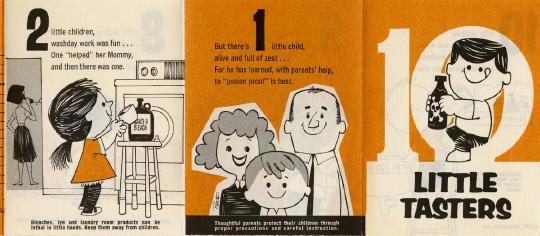
Timeline

1930
Dr. Jay Arena begins as a medical student at the new Duke Medical School.
1933
Dr. Arena is appointed pediatric resident at Duke Hospital.
1934
Dr. Arena and Dean Wilburt Davison note the dangers of lye poisons and attempt to get the sale of lye banned in NC.
1937
Dr. Jerome Harris, Chair of the Department of Pediatrics from 1954 to 1969, joins the Duke faculty.
1940s-1950s
Aspirin poisoning constitutes 25% of all poisonings in children.
ca 1943-1946
The first flavored children's aspirin is produced.
1950s
Dr. Arena and Dr. Harris develop a 24-hour call system for the second-year pediatric residents to handle the so-called “poison phone calls” that are generated.
Dr. Shirley Osterhout, who obtained her MD from Duke in 1957, begins her pediatric residency with Dr. Arena.
Dr. Arena leads the push for drug companies to develop a childproof safety cap for medicine bottles.
1951
A survey conducted by the American Academy of Pediatrics Committee on Accident Prevention reveals that the majority of accidents in pediatric cases are poisonings.
1953
First Poison Control Center is established in Chicago.
1954
Duke establishes the second Poison Control Center in the United States.
Dr. Harris assumes the position of Chair of the Department of Pediatrics and continues in this role until 1969.
1955
The “Reminder CAP” was introduced by St. Joseph Aspirin for Children but it would go through a series of testing to determine effectiveness.
1957
The National Clearinghouse of Poison Control Centers is created, enabling poison control centers to centralize information and statistics.
Final report of surveys conducted to determine which of three closures would be most effective from a safety standpoint in reducing the chance of small children getting access to aspirin containers (either children or adult size) or other medication containers kept in the house.
1958
The American Association of Poison Control Centers is created to improve the quality of poison treatment services and develop national standards.
1959
Dr. Arena leaves the Duke Poison Control Center to be a national speaker and writer on poison control topics.
Dr. Osterhout assumes the role of Medical Director of the Duke Poison Control Center.
The Poison Control Center relocates its files from the pediatric resident's office to a bigger space in the ER treatment room.
“Safety Closure Caps: Safety Measure for Prevention of Accidental Drug Poisoning in Children” is published in the Journal of the American Medical Association.
1960s and 1970s
Dr. Arena acts as expert witness in court cases involving ingestion of poisons.
1960
The Uniform Hazardous Substance Act (Child Safety Act), requiring warning labels on hazardous household products, is passed.
1967
Approximately 550 poison control centers have been established in the United States.
Dr. Arena is appointed by the Food and Drug Administration (FDA) to serve on the Committee to Develop Standards for Safety Closures.
1969
Dr. Arena testifies before the Senate Committee on Commerce to support passage of the Poison Prevention Packaging Act.
1970s and early 1980s
A national movement begins to regionalize and improve services of poison control centers.
1970
Your Child and Household Safety by Dr. Arena is published and distributed by the Chemical Specialties Manufacturers Assocition, Inc.
1971
Dangers to Children and Youth by Dr. Arena is published.
1972
The hours and roles at the Duke Poison Control Center, once primarily filled by pediatric residents, are now being managed by poison information specialists during certain hours.
1973
Wanting to prove that their toys were absolutely safe, Questor Education Products submits some of its toys to rigorous safety testing by Dr. Arena and Dr. Samuel Southard, Chief of Pediatrics, Atlantic City Medical Center.
1976
Dr. Arena serves as consumer representative on the Technical Advisory Committee on Poison Prevention Packaging for the Consumer Product Safety Commission.
1977
Aspirin poisoning is reduced to 5% of all poisonings in children.
1978
Dr. Osterhout serves as consumer representative for the Consumer Product Safety Commission's Technical Advisory Committee on Poison Prevention Packaging.
Child Safety is No Accident, written by Dr. Arena and Miriam Bachar (UNC School of Public Health), is published. This reasource is heavily illustrated by Robert Blake, medical artist at Duke from 1941-1983.
1979
Dr. Arena retires from Duke University in 1979. The Jay Arena Fund in Pediatric Pharmacology and Toxicology is established in his honor.
1980-1983
Dr. Osterhout serves as a consultant on the FDA's Gastrointestinal Drugs Advisory Committee of the Bureau of Drugs.
1984
The Duke Poison Control Center is officially certified by the American Association of Poison Control Centers. The requirement that poison specialists staff the Center 24 hrs. a day officially ends the pediatric residents’ involvement in the Center.
1985-1995
Dr. Osterhout serves as Medical Director of the Duke Poison Control Center.
1995
The Duke Poison Control Center closes.
